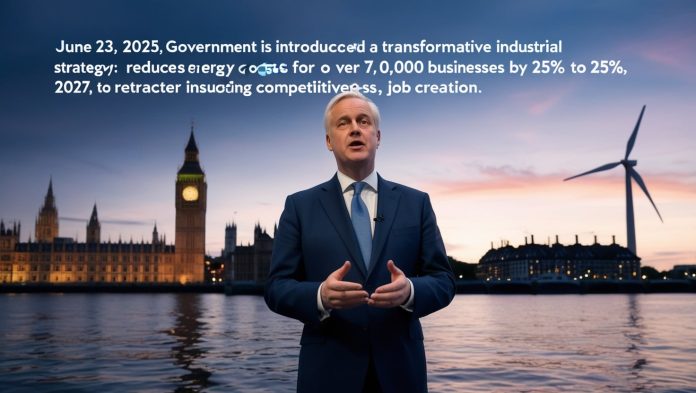The UK government launched a ground-breaking 10-year industrial strategy on June 23, 2025, to rejuvenate the country’s economy. Prime Minister Keir Starmer announced that the strategy would cut the energy bills of thousands of businesses, marking a strong drive towards growth.
Business Energy Relief Scheme
More than 7,000 business organisations in the UK will experience a 25 percent reduction in their electricity prices by 2027. The British Industrial Competitiveness Scheme is addressing energy-intensive industries such as automotive and aerospace by reducing costs by 40 per megawatt-hour by exempting companies from green energy charges.
Boosting Growth Amid Challenges
This plan aims to deal with slow economic growth, as the UK’s GDP is expected to increase by only 0.2% in Q2 2025. Due to the limited growth in the private sector, which was championed by services, there are high energy costs, especially for manufacturers, leading to government interference in increasing the country’s global competitiveness.
A Long-Term Perspective
The Starmer strategy leans towards long-term investments and plans to generate 1.1 million well-paid jobs. The government aims to establish Britain as the destination of first choice for business investments by 2035. In this endeavor, the government ensures that all the planning processes are streamlined and that capacity provision is explicitly made for significant projects.
Industry Cooperation
The government will implement the strategy in collaboration with energy sectors, local authorities, and trade unions. The Planning and Infrastructure Bill will have new powers to fast-track project approvals and minimise delays that have been a setback to industrial development in recent years.
Carbon Pricing and the Global Trade
The UK will connect its trading system with that of the EU to ease pressure on companies to pay high carbon taxes. This step will make British firms competitive in the international market and retain money in the UK to strengthen the local sectors.
Divergent Reactions by the Stakeholders
Business circles applauded the strategy as it aimed at cutting costs. However, its opponents, including opposition members, claim that it does not solve the real causes of high energy prices since the government has been using taxpayers’ benefits in the form of subsidies.
Service Sector Set to Become Optimistic
The brighter economic outlook was motivated by services industry with a PMI of 51.3 in June. The records of the volume of new businesses show that they recorded growth after six months. This robustness cancels out the challenges in manufacturing, which gives a groundwork for the ambitious plans of the strategy.
Woes in Manufacturing Endure
As much as service corporations are performing well, manufacturing is being affected by global uncertainties and costs. The strategy’s energy cost reductions are to ease these pressures. However, which businesses will qualify will take a refreshing two years to decide, so little relief will be seen immediately.
Economic Situation and Future
In Q1 of 2025, the UK economy expanded by 0.7 percent and then contracted in April owing to the effects of tariffs and tax changes. The Bank of England envisages a growth of 1 percent in the year 2025, and therefore, it is important to have some interventions that would help advance the process.
Infrastructure Investment
The plan is to expand the British Business Bank’s capacity to 25.6 billion pounds. This investment is due to Starmer’s wider infrastructure strategy and aims to renew the economy by reaching small businesses and speeding up growth nationwide.
Crises in Politics and the World
The increasing cost of oil due to Middle East conflicts risks economic stability. Chancellor Rachel Reeves also focused on the necessity of de-escalation to reduce the consequences for UK businesses, and this strategy is easier to maneuver in the turbulent global economy.
A Focus on Small Businesses
Liberal Democrat MP Sarah Olney demanded that the focus be put on small enterprises confronted with the highest energy costs. The government’s strategy assumes measures to facilitate SMEs by giving them an opportunity to enjoy lower bills and deregulation.
Reforms on Public Procurements
The approach transforms the procurement of goods and services for citizens and reduces the obstacles that SMEs and new players face. The government is seeking to boost the country’s competitiveness at the domestic level to empower local firms and achieve innovation and economic resiliency within the UK.
Push of Regional Development
An accelerator of Strategic Sites worth 600 million pounds will develop more investible sites in the city regions. Increased National Wealth Fund and British Business Bank provision is expected to open the regions and establish successful industrial agglomerations.
Sustainability and Competitiveness
The exemptions of green levies on businesses have come under attack. It lowers expenses, as others claim that it decreases net-zero targets. Government is insistent in suggestions that the connection of carbon pricing and the EU is a balance between sustainability and competitiveness of industry.
Business Confidence Erratic
Business confidence took a dive in June as global uncertainties were expressed. Nonetheless, future growth expectations increased marginally, which implies that the promises of reduced expenses and simplified processes implied in the strategy have a chance of revitalizing the UK’s economic horizon.
A Ten-Year Turnaround
Starmer believes in the power of industrial strategy, which is central to his Plan for Change. It targets making Britain a pacesetter in industrial innovation by addressing energy costs, infrastructure, and trade globally.
Challenges Ahead
Nevertheless, the need to cut jobs and international trade conflicts are threats in spite of the optimism. The success of the given strategy depends on how well it will be implemented and how well relevant stakeholders will cooperate to bring practical benefits to companies in the country.
Call to action
The industrial strategy provides an ambitious playbook for navigating economic headwinds. By reducing energy charges and creating investment, it hopes to arm businesses and make Britain prosper in a competitive international environment.



 Bitcoin
Bitcoin  Ethereum
Ethereum  Tether
Tether  XRP
XRP  USDC
USDC  Lido Staked Ether
Lido Staked Ether  TRON
TRON  Cardano
Cardano  Avalanche
Avalanche  Toncoin
Toncoin  Solana
Solana